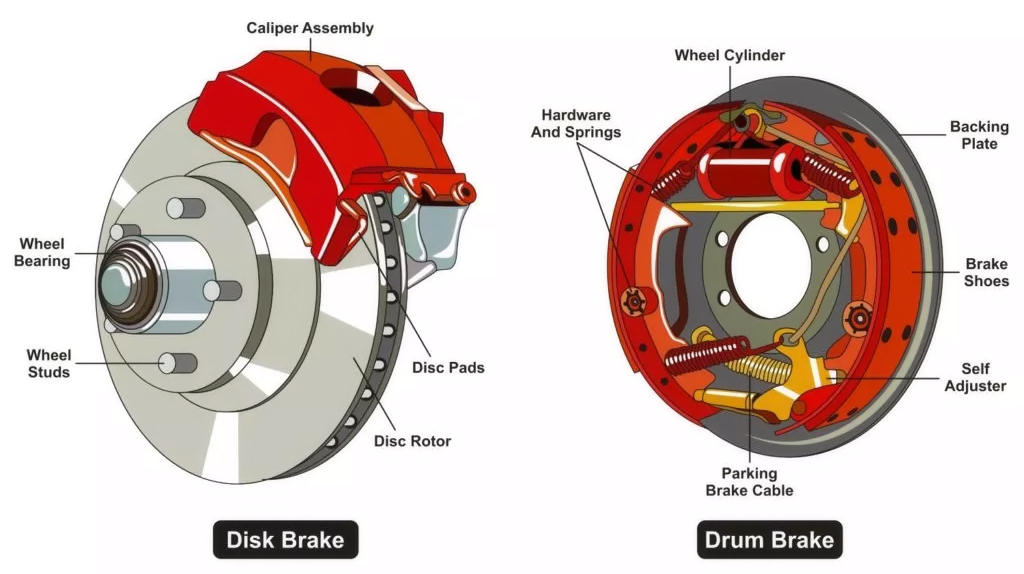Brakes - Disc vs. Drum
This section is NOT intended to rehash the history of drum and disc brakes, there are a lot of pages on the Internet that get into the history of both. That being said, the 1967 Chevelle model year was the first year front disc brakes would be offered under RPO J52 (1). Included with the disc brake option in 1967 only were special slotted 'rally' wheels. The SS396 got 14x6 slotted rally wheels where all other Chevelles got 14x5 slotted rally wheels. These slotted rally wheels in 1967 were NOT an option themselves. Power brakes (RPO J50) were a separate option for both front disc and drum brakes.
The 1967 and 1968 disc brakes were a 4-piston design where 1969-1972 were a more efficient 2-piston design. Unlike the 1967 model year, steel wheels were standard with disc brakes and the 'rally' wheel was now optional on any Chevelle. The wheel size(s) were dependent on the series and whether disc brakes were ordered.
The 1969 model year saw a change in the disc brake option with the change to a 2-piston design. Again, disc brakes were optional on any Chevelle. When the SS 396 option was ordered, part of the Z25 option was power front disc brakes along with SS-only wheels. No other wheel was an option with the SS 396 option and the SS--only wheels were not an option on any non-SS 396 Chevelle. The same is true for both the Z25 and Z15 option for 1970-1972.
The 1969 and early 1970 hub and rotors were two pieces. Around the April/early May of 1970 timeframe a change was made to single hub/rotor unit. On 1970 build sheets in box #12 "STRG KNUCKLE" early 2-piece are coded as "AS" where later one-piece are coded as "DT."
See my page on Chevelle wheels in the Decode section for sizes and specifics.
It is often asked if rear disc brakes are necessary. I'm sure one will get opinions on both side of the discussion. Many of the sportier American cars in the 90s and 00s along with light trucks came equipped with front and rear disc brakes. Except in a narrow range of applications rear disc applications were no better at stopping the vehicle than front-only disc brakes.
Problems have recently cropped up with rear disc brakes. GM once issued a recall for thousands of pickups with rear disc brakes due to road salt causing corrosion that moves the ABS sensor away from the wheel, rendering it unable to correctly read wheel speed. This results in the ABS system coming on at the wrong time resulting in extremely long stopping distances. Another thing to consider is your parking brake. With rear drums the parking brake sets the brake shoes against the drums as opposed to disc pads to the rotors. As disc brakes cool, they the pads contract and may lose contact with the rotor causing the parking brake to not work. Some aftermarket rear disc brake suppliers offer an electronic parking brake retrofit kit.
One advantage of disc brakes is their life expectancy. On average the disc pads and rotors should last 50,000 to 70,000 miles under 'normal' use. For most of us that's a good life span for our Chevelles, even daily drivers unless you're in an environment of heavy traffic with constant stop and go driving at speeds. Many lucky Chevelle owners have their Chevelles as a second or third car and only bring them out in good weather to cruises or car shows. To the (I'll use the term) 'casual' driver is converting to rear disc brakes worth the money? Only you can answer that. If you're objective is doing some gymkhana racing, four-wheel discs are certainly worth the expense.
One thing for certain, whether you're adding rear disc brakes or just converting your front drum brake setup to front discs, don't go cheap. Cheap brakes are like buying a 12v. fan is to keep you cool as opposed to air conditioning, plus your life and the lives of your family depend on good brakes. All the chrome and dress-up goodies aren't worth much if you cannot stop. Another thing to consider if doing a disc brake conversion is your wheels. Due to the caliper, often wheels with more offset are required, especially if going to 10-inch or larger rotors. Be sure to check with your disc brake supplier for wheel needs (both size, i.e., 15-inch or larger wheels) and wheel offset. It would be a shame to find out your $1,000-$2,000 set of custom wheels and new tires will not work with the disc brake package you are considering.

(1) Not available if RPO J65 metallic brakes are ordered.
© ChevelleWorld

 1964 Chevelle
1964 Chevelle 1965 Chevelle
1965 Chevelle 1966 Chevelle
1966 Chevelle 1967 Chevelle
1967 Chevelle 1968 Chevelle
1968 Chevelle 1969 Chevelle
1969 Chevelle 1970 Chevelle
1970 Chevelle 1971 Chevelle
1971 Chevelle 1972 Chevelle
1972 Chevelle


